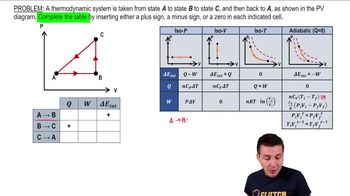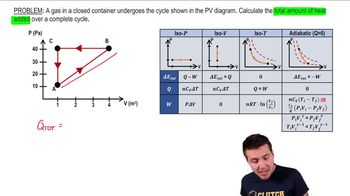22. The First Law of Thermodynamics
Cyclic Thermodynamic Processes
Practice this topic
- Multiple Choice
An ideal gas is taken through the four processes shown below. The changes in internal energy for three of these processes are as follows: ΔEAB = +82 J; ΔEBC = +15 J; ΔEDA = –56 J. Find the change in internal energy for the process from C to D.
990views2rank - Textbook Question0.25 mol of a gas are compressed at a constant pressure of 250 kPa from 6000 cm^3 to 2000 cm^3, then expanded at a constant temperature back to 6000 cm^3. What is the net work done on the gas?368views
- Textbook QuestionA heat engine using a diatomic gas follows the cycle shown in FIGURE P21.55. Its temperature at point 1 is 20℃. a. Determine Wₛ, Q, and ∆Eₜₕ for each of the three processes in this cycle. Display your results in a table.392views
- Textbook Question
(II) An ideal gas expands at a constant total pressure of 2.5 atm from 410 mL to 690 mL. Heat then flows out of the gas at constant volume, and the pressure and temperature are allowed to drop until the temperature reaches its original value. Calculate
(a) the total work done by the gas in the process, and
(b) the total heat flow into the gas.
200views - Textbook Question
(II) A 1.0-L volume of air initially at 3.5 atm of (gauge)pressure is allowed to expand isothermally until the (gauge) pressure is 1.0 atm. It is then compressed at constant pressure to its initial volume, and lastly is brought back to its original pressure by heating at constant volume.
(a) Draw the process on a PV diagram, including numbers and labels for the axes.
191views



